I am in the process of answering a letter (yes, a letter written by hand and sent by post!) from Pierre La Plante of Canada. Pierre is a long ago customer. He sticks in my memory as a young man, who many years ago sailed his Hitia 17 down the St Lawrence River, Canada. After having restored and sailed a small deep-keel monohull for a few years, he now wants to go back to a shallow draft catamaran and wants to build a Tiki around 24ft long.
Canadians who regularly sail in the St. Laurence River area need to be tough, alert sailors. Pierre ended his letter of enquiry with this P.S. "Do not forget the priorities, a hot soup, a dry bunk and a good book".
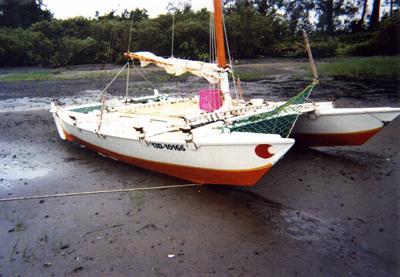
I have been thinking a lot about small boats recently. We have just built and are test sailing our own small boat, the 27ft Amatasi. The News every day is dominated by the financial and economic crisis around the world; in this frugal climate, for many people with dreams to go sailing, a small boat will be all they can afford. This is not new in the history of sailing.
In July of this year I met two small boat sailors of the past. Patrick Ellam and Colin Mudie were in Falmouth for the 60th Anniversary of their departure from Falmouth in 1951 on 19'8" Sopranino.
Sopranino was/is a tiny Fin-Keeled light displacement boat, which the two young men sailed from Britain to Spain and across the Atlantic along the same route I sailed with 23’6” Tangaroa in 1955-56.
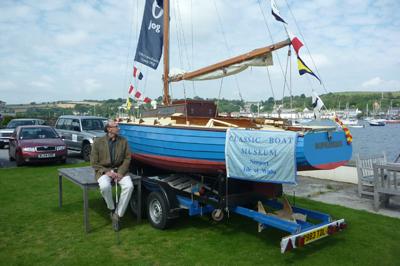
This was the time just after WWII. Both men in their 20's had what could be described as a "Hard War" making them tough and fearless. Patrick Ellam honed his sailing skills by racing in sailing canoes of around 17-20ft across the Channel in all weather conditions. From these experiences he decided that a light, slim, decked, dinghy style hull, held upright with a fin keel could survive the Ocean seas.
In the early 1950's money and boat building materials were in short supply. However Patrick had enough money to have the small boat, designed by Laurent Giles, built in a quality boatyard.
They wrote the story of their voyage in the book "Sopranino", which after meeting the now two old men I reread.
Living accommodation aboard was fully in accordance with Pierre La Plante's priorities, "Hot soup, dry bunk and a good book". Sopranino’s voyage and the subsequent book were an inspiration to many, including me, aged 26, when I designed and built not a Mono Hull, but a 23' Pacific Double Canoe, now called a ‘Catamaran’, and sailed it across the Atlantic Ocean.
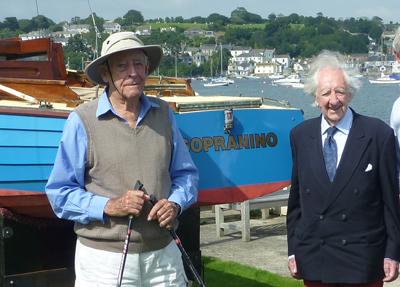
The 23' 6" Catamaran ‘Tangaroa‘ was not, in my present design concepts, the most beautiful of my designs, but it did carry three people, a dog and 200 books on a multihull pioneering voyage across the Atlantic from Britain to the West Indies. In considerably more comfort than on the "Sopronino"!
In 1979 I met Meade Gougeon at a Dutch Yacht Design Symposium, where he gave a lecture on their new concept of using ‘WEST’ (wood epoxy saturation technique) in small boat construction. During a lunch break, in conversation with him I said that with the use of their new construction material (WEST epoxy) I could design catamarans, easier to build, lighter in construction, and more durable.
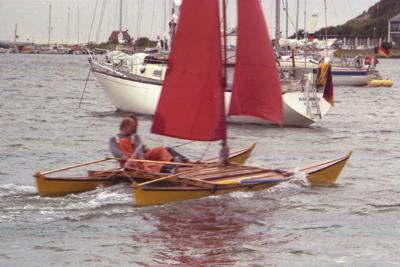
In 1980 we designed and built a 14' proto type, in ‘stitch & glue’ ply and WEST epoxy, the Hitia. Everyone who sailed her loved it! So on the basis of the experiences of the 14' Hitia we designed the car trailable Tiki 21. It was an immediate success. In 1982 it won the "Cruising World" prize for ‘a trailable Gunkholer’.
The Tiki 21 is still a prize winning boat. In 1992-97 the young Rory McDougall sailed his 21' Tiki ‘Cooking Fat’ around the world! In 2011 he entered her in the single-handed Jester Challenge and came in a close second. Read more:
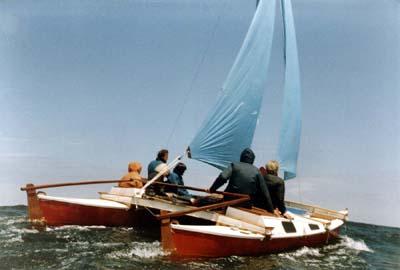
To sum up, I began this story with Pierre La Plante’s essential sailing comfort priorities: "Hot food, a dry bunk with comfort to read a good book". In the present economic crisis there is a lot to be said for a small boat that can take you on your dreams.
- James Wharram
